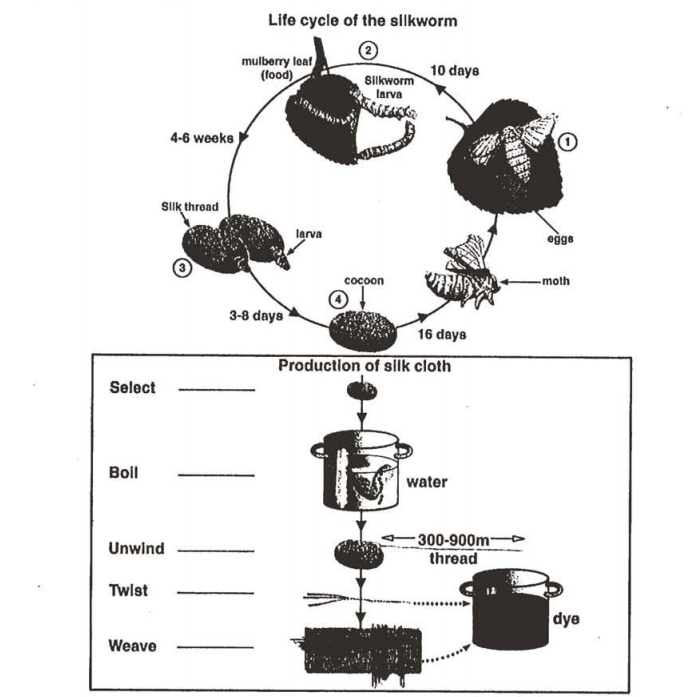The IELTS Academic Writing Task-1 comprises of many variations. The task is required to be described or summarized in our own words. The given picture, may be a line, bar or a pie chart or pre-post development area pictures or data table or a process flow chat and a combination of these. It is a simple task because no information or idea needs to be added from the candidate’s side. However, one has to be perfect in grammar, sentence construction and using synonyms for the various categories, trends or processes. Still a lot of students or aspirants find it difficult to justify this task, which can support the band score, if prepared well. Today, I will discuss the finer points of Process Flow or Methodology task, with the help of an example.
A process flow is a diagram which comprises of various steps to produce, generate or explains something happening in consecutive (sequential) or parallel (simultaneous) or converging (fusion) steps. A process has a starting step, succeeding steps, preceding steps, a penultimate step and a final step. For describing a sequence of steps, the following words can be used, wisely:
For starting a process flow: Initially, Firstly, To start with, To begin with, To initiate, To start the ball rolling, to commence, to kickstart or any other relevant phrase.
For Succeeding Steps: Next, Secondly, Thirdly, Subsequently, After this, The next step is, In the next, In the following, Followed by, Succeeded by, Then, In the next stage, and then, In the subsequent step, Moving forward, Furthermore.
For the step before the final step: The last but one, the penultimate, last step before finalization,
For the final step: Finally, in the last, to finish, to get the final output, to reach the final stage, the culminating step is, the finishing touches, and the ….. is ready for, the final outcome, as a result of the previous steps, the preceding processing leads to, the product is finalised/finished/made ready/ready to use/ready to be transported/ the final destination, Moving to the final step
Next important element is the construction of sentences. In the process flow chat, mostly simple present tense, that too in active voice is used. Although, if required, passive voice and present perfect can be used.
The mixture passes through or is passed through
The process starts with or the process is initiated by or with
Then it goes through or is mixed with or is put through
The it reaches the or it comes out of the…to move to….
Finally, the product is received as or finally, it reaches or it is packed or it is used or it is transported.
A care has to be taken about singular or plural auxiliaries (is/are)
The comes the vocabulary for the specifics in the process. We will take an example and try to make the things easier for the candidates. Let’s take a problem.
The diagrams show the life cycle of the silkworm and the stages in the production of silk cloth. Summarize the information by selecting and reporting the main features.
Write at least 150 words.

If we look at the diagram, it shows a moth becoming a silkworm, which turns into a silk cocoon. The either the cycles repeats or the silk thread is taken from it and woven into a cloth. This the whole process divided into various steps.
Vocabulary can be: silkworm, insect, feeding, mulberry leaves, weaves around itself, time duration, number of days, time period, fibre, thread, a long thin wire of, two options, put into boiling water, spun into, drawn into, making of silk yarn by winding together, converted into cloth, yarn is dyed or colored.
Let,s start.
1. First Step is to define the problem by para-phrasing it in simple words of your own. Do not try to copy the given problem. Try to redefine the statement in your own words.
Para one: The given process flow/ picture/ method describes /presents /delineates /gives details of the developmental stages of a silkworm into a silk cocoon, followed by the methodology of getting textile from the silk. It is summarized below.
Para two: It is crystal clear that the moth lays eggs on the leaf of a mulberry tree and hatch into larvae after 10 days, which eat the leaves to get developed into silkworms to start secreting silk thread around themselves after a span of 28 to 42 days. Subsequently, the silkworms get trapped into final cocoon of silk . At this stage there are two paths. If the cocoon is left undisturbed, it again converts into a moth to restart the life cycle of a silk worm. Otherwise, it starts its journey of becoming a silk fabric.
Para Three: To initiate the conversion of cocoon into the final textile, the silk covering of silkworm is put into extremely hot water, in which the insect is separated from the silk case. After that a long wire up to 900 m is drawn from it. Next, a number of long silk fibres are converted to yarn by twisting. Finally, either the silk cord is directly colored or dyed after weaving it into a fabric.
Conclusion: Overall, the journey of a silkworm has two fates. Either it starts its new life-cycle or becomes a commercial product.
The above is an example of writing a process. A candidate can have any style of describing. However, the sentences have to be in any voice of simple present tense. The main focus is clarity in description, smooth process flow, impeccable grammar (subject-verb agreement) and relevant synonyms, wherever possible.
I hope it will help the candidates to learn about the Task-1 regarding a process flow chart/diagram. The suggestions are welcome for any specific task to be undertaken in the next post.